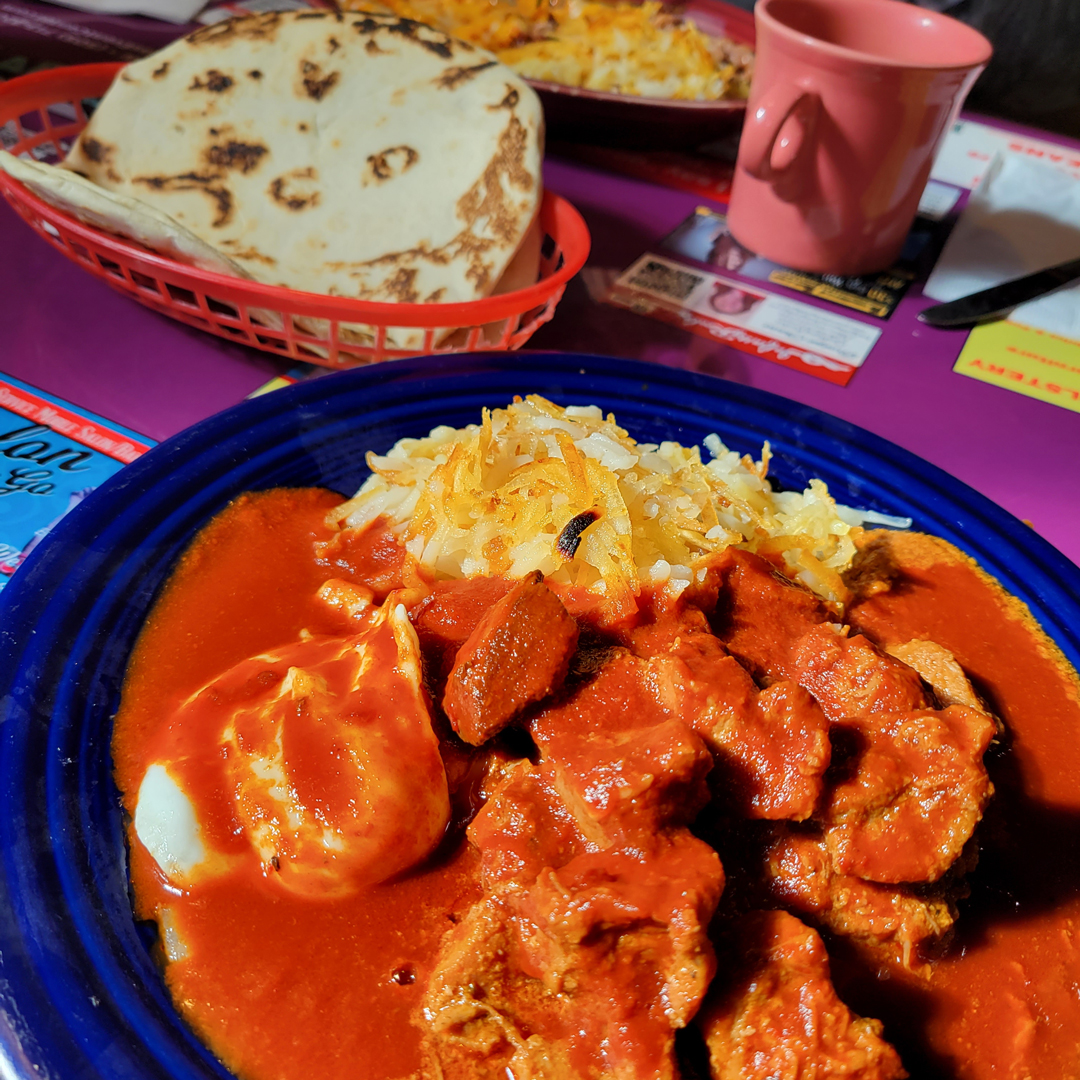#16 | Red or Green, Chile Pasado, and Delicious Things
For a long time, in the centuries before widespread refrigeration, freezing, and canning, the question of red or green was largely a seasonal one. Eating a meaty chunk of roasted green chile was a fall treat, and otherwise the chile was as red as the dried red pods that kept year-round. The now ubiquitous question of red or green, which was adopted as the official state question in 1999, is then in large part as much of a reflection of modern technology as it is of tastes.
But not totally. There is, in fact, an old way of eating green year-round by drying the roasted peppers to create chile pasado. Roasted and peeled green chiles would be hung to dry in the sun, and the resulting dried green could be rehydrated and cooked similarly to red pods. For an example, there’s Eloisa Mendez’s recipe for chile pasado from a collection published in 1993, which calls for 6 sun-dried green chiles, soaked until soft. Fry 2 pork chops in 2 tablespoons of oil until tender, she writes, then add onion, tomato, and garlic. Chop the rehydrated chile and add to the meat, bring to a boil, and cook for 20 minutes.
While dishes like this were once far more common, it is now so rarely done with New Mexico chiles that we have never seen or tasted it in any New Mexican restaurant. But we’re curious: Have you?
We ask because it’s fall and the scent of roasting green still wafts through our mind. Also, Red or Green? is the question behind our next issue, which comes out later this week.
In the meantime: grab a copy of the Movie Issue before they’re gone. Live out of state or just want to make sure you get every issue? Consider a subscription.

Delicious Things
All this talk of chile reminds us of a favorite holiday crowd pleaser: soft mild goat cheese rolled in piñons and drizzled with local honey, served with a generous halo of chopped green chile and a good baguette.
Entrances & Exits
After working in kitchens from Atlanta to Marina del Rey to West Hollywood, Dakota Weiss has returned to Santa Fe to join Coyote Cafe as the executive chef.
Crash Murder Business Coffee is now open in Santa Fe. They’re mixing eclectic drinks like the Streak of Tigers, which involves chocolate and charred cedar bitters and other things. And they share our fondness for collective nouns (lounge of lizards, raft of turkeys).
Ale’s Cakes: a new cupcake shop on Albuquerque’s Westside that also serves breakfast and lunch. Their menu of sweets is balanced out with smoothies, vegan sandwiches, chilaquiles, and specials like enchiladas suizas, which we happen to be a fan of.
Summer farmers markets are nearing the end of their season, so get there while you can. Today is the last day for summer hours at the Taos Farmers Market, and they’ll be open 9 am to 12 pm the first three Saturdays in November. November 6 is the last day to hit the Downtown Growers’ Market in Albuquerque. The Santa Fe Saturday Farmers’ Market, the Tri-County Farmers’ Market in Las Vegas, and the Farmers & Craft Market of Las Cruces are all open year-round.
If you find yourself in Brooklyn and craving a taste of home, two New Mexican transplants are serving green chile cheeseburgers and other familiar fare at the newly opened Santa Fe BK in Williamsburg.
Pop-Ups & Festivals
Pranom Pop-up, originally from LA but currently kinda nomadic, is offering Thai street food at places like Sister (November 5), High and Dry (November 8), and Sidetrack (November 10) in Albuquerque, and at the Breakroom location of Santa Fe Brewing on November 7.
Tomorrow’s Women, a nonprofit partly based in Santa Fe, is hosting a virtual cooking class tomorrow from 10 am to 11:30 am, featuring shakshouka.
The Marigold Parade will not take place this year in Albuquerque’s South Valley, but Ofrendas Comunitarias: Muertos y Marigolds will be on exhibition at the Gutiérrez Hubbell House through November 13.
Distillations
Red or Green? might officially be the question, but a more sobering question for New Mexico, writes Wufei Yu for High Country News, is “Can its iconic crop weather the changing climate?”
How did the chile pepper, native to the Americas, become adopted and adapted into a ubiquitous and culturally significant crop in China? Historian Brian Dott explains in this A Taste of the Past podcast from last year.

Live out of state or just want to make sure you get every issue? Consider a subscription to The Bite.







